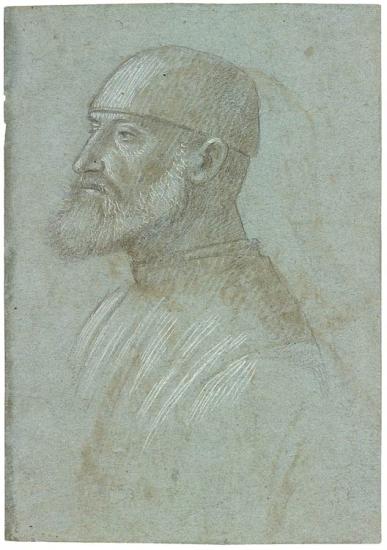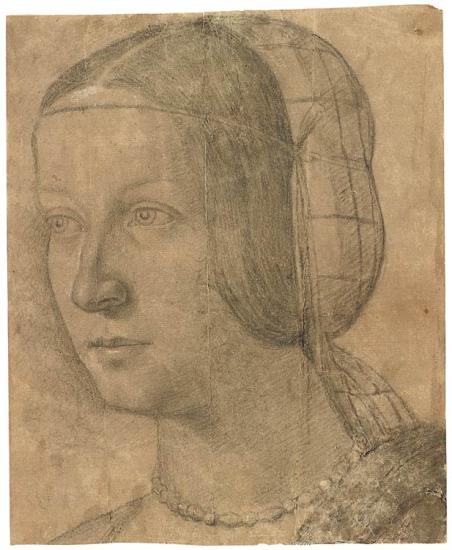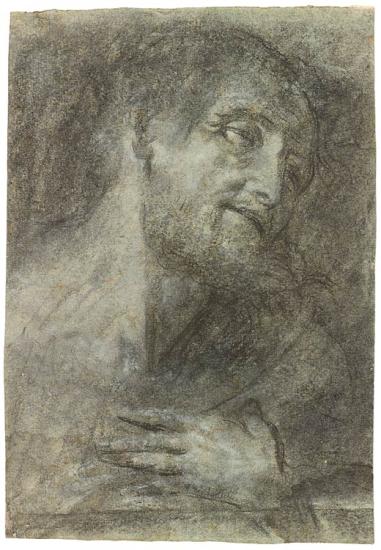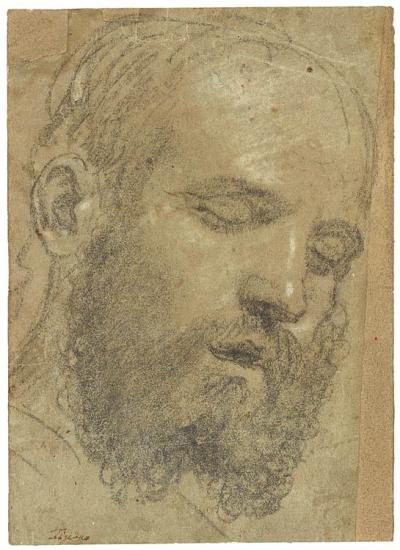Portraiture
Inspired by earlier northern European models, Venetian artists of the sixteenth century approached portraiture with a new naturalism. Portraits of individuals were commissioned to document physical likeness as well as social status, often conveyed through opulent clothing and lavish settings. Initially, most sitters were portrayed in strict profile, much like the depictions on ancient coins. Later, evocative three-quarter or frontal views dominated, inviting a more direct and intimate relationship with the viewer. In Venice and northern Italy, group portraits became fashionable. The artist Palma Giovane, for example, produced numerous quick sketches of his large family and wide circle of friends. Through the work of such artists as Carpaccio, Titian, Veronese, and Tintoretto, Venice established a remarkable portraiture tradition.
Vittore Carpaccio

Head of Bearded Man Wearing a Cap, in Profile to the Left
Purchased by Pierpont Morgan, 1909
Carpaccio's large narrative scenes made for Venetian scuole—lay confraternities run by merchants and citizens excluded from politics because they were not of noble blood—often included likenesses of the institution's dignitaries. This drawing has been associated with the artist's Life of Saint Ursula cycle (Accademia, Venice), although no equivalent figure appears in those paintings.
The typically Venetian technique of brush drawing on blue paper became highly advanced in the hands of Gentile Bellini and Carpaccio.
Portraiture
Inspired by earlier northern European models, Venetian artists of the sixteenth century approached portraiture with a new naturalism. Portraits of individuals were commissioned to document physical likeness as well as social status, often conveyed through opulent clothing and lavish settings. Initially, most sitters were portrayed in strict profile, much like the depictions on ancient coins. Later, evocative three-quarter or frontal views dominated, inviting a more direct and intimate relationship with the viewer. In Venice and northern Italy, group portraits became fashionable. The artist Palma Giovane, for example, produced numerous quick sketches of his large family and wide circle of friends. Through the work of such artists as Carpaccio, Titian, Veronese, and Tintoretto, Venice established a remarkable portraiture tradition.
Anonymous Italian artist

Portrait of a Woman with a Hairnet
Gift of H. P. Kraus, 1961
The artist who drew this sensitive portrait remains unknown. It probably was made during the first quarter of the sixteenth century by an individual from the Veneto or Lombardy working in the circle of Giovanni Bellini, Francesco Bonsignori, or Bartolomeo Veneto.
The sitter's headdress derives from Leonardo's Portrait of a Woman, known as La Belle Ferronière (Louvre, Paris). Painted in the 1490s, that work was much studied during the early years of the sixteenth century.
Portraiture
Inspired by earlier northern European models, Venetian artists of the sixteenth century approached portraiture with a new naturalism. Portraits of individuals were commissioned to document physical likeness as well as social status, often conveyed through opulent clothing and lavish settings. Initially, most sitters were portrayed in strict profile, much like the depictions on ancient coins. Later, evocative three-quarter or frontal views dominated, inviting a more direct and intimate relationship with the viewer. In Venice and northern Italy, group portraits became fashionable. The artist Palma Giovane, for example, produced numerous quick sketches of his large family and wide circle of friends. Through the work of such artists as Carpaccio, Titian, Veronese, and Tintoretto, Venice established a remarkable portraiture tradition.
Giovanni Girolamo Savoldo

Head and Shoulders of a Bearded Man
Gift of Benjamin Sonnenberg, 1977
Brescian by birth, Savoldo lived in Venice from at least 1520 until 1548. He was an exceptionally rare draftsman, to whom only about fifteen drawings have been attributed. His drawings exhibit the same sense of atmosphere and luminosity that characterize the chalk drawings of Titian, Lotto, and other painters of the Venetian school.
The sitter is shown in contemporary dress. His sidelong glance leveled at the viewer and full lips—parted as if about to speak—make this one of the most intriguing of Savoldo's portraits.
Portraiture
Inspired by earlier northern European models, Venetian artists of the sixteenth century approached portraiture with a new naturalism. Portraits of individuals were commissioned to document physical likeness as well as social status, often conveyed through opulent clothing and lavish settings. Initially, most sitters were portrayed in strict profile, much like the depictions on ancient coins. Later, evocative three-quarter or frontal views dominated, inviting a more direct and intimate relationship with the viewer. In Venice and northern Italy, group portraits became fashionable. The artist Palma Giovane, for example, produced numerous quick sketches of his large family and wide circle of friends. Through the work of such artists as Carpaccio, Titian, Veronese, and Tintoretto, Venice established a remarkable portraiture tradition.
Paris Bordone

Head of a Bearded Sleeping Man
Inscribed at lower left, in pen and brown ink, Tiziano.
Gift of Janos Scholz, 1981
In comparison to Bordone's more forcefully drawn Standing Man Playing a Viola da Gamba, here the emphasis is on the shimmering surface of the subject's skin. The artist was strongly influenced by the chalk style of Titian, to whom the present sheet was once ascribed. The candid naturalism of this intimate study of a sleeping man suggests it was done from life.
Of the several paintings and frescoes by Bordone that feature similar sleeping figures, the artist's Last Supper in San Giovanni in Bragora, Venice, in which St. John rests his head on Christ's shoulder, relates most closely to this drawing.
Portraiture
Inspired by earlier northern European models, Venetian artists of the sixteenth century approached portraiture with a new naturalism. Portraits of individuals were commissioned to document physical likeness as well as social status, often conveyed through opulent clothing and lavish settings. Initially, most sitters were portrayed in strict profile, much like the depictions on ancient coins. Later, evocative three-quarter or frontal views dominated, inviting a more direct and intimate relationship with the viewer. In Venice and northern Italy, group portraits became fashionable. The artist Palma Giovane, for example, produced numerous quick sketches of his large family and wide circle of friends. Through the work of such artists as Carpaccio, Titian, Veronese, and Tintoretto, Venice established a remarkable portraiture tradition.